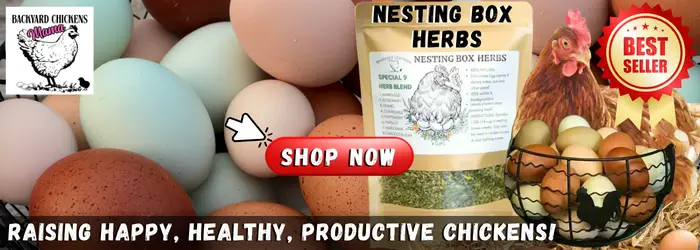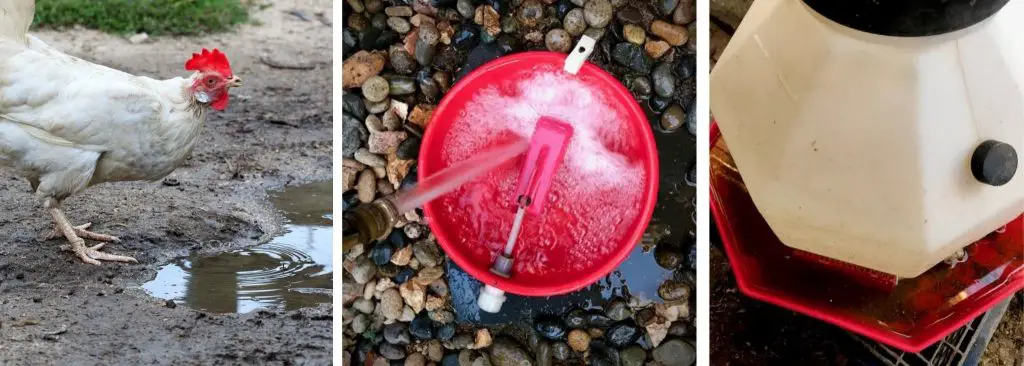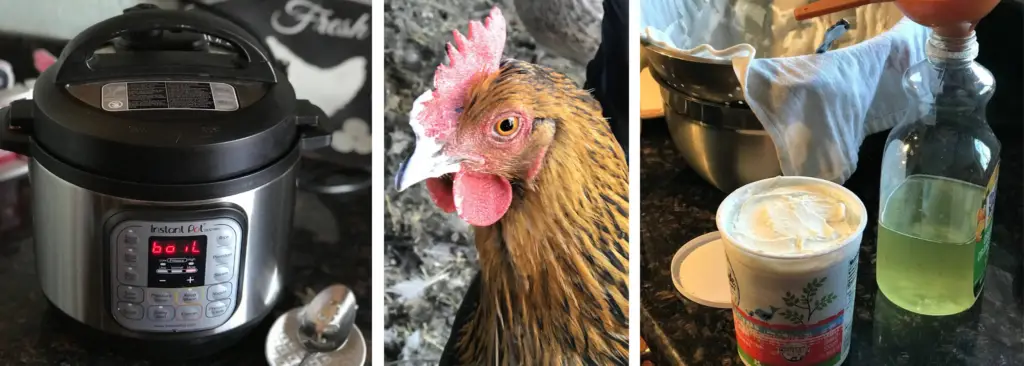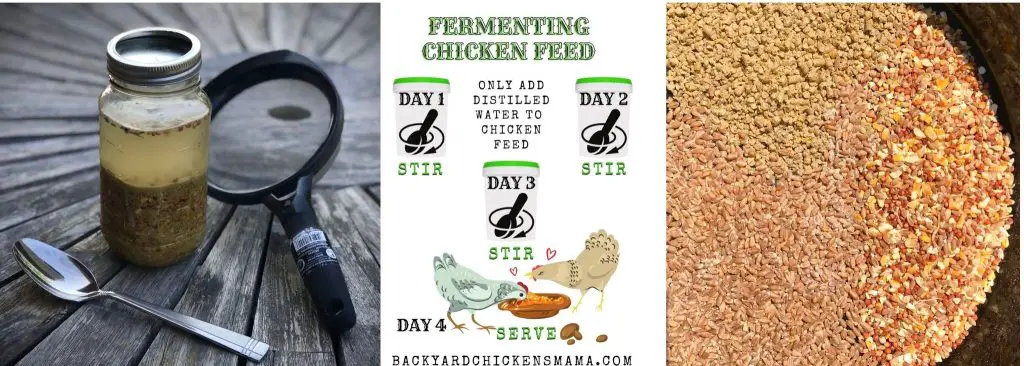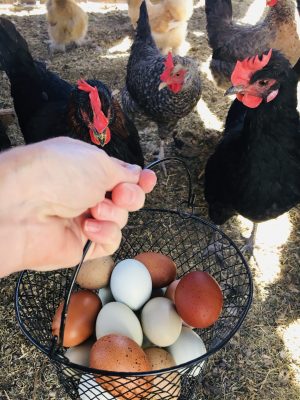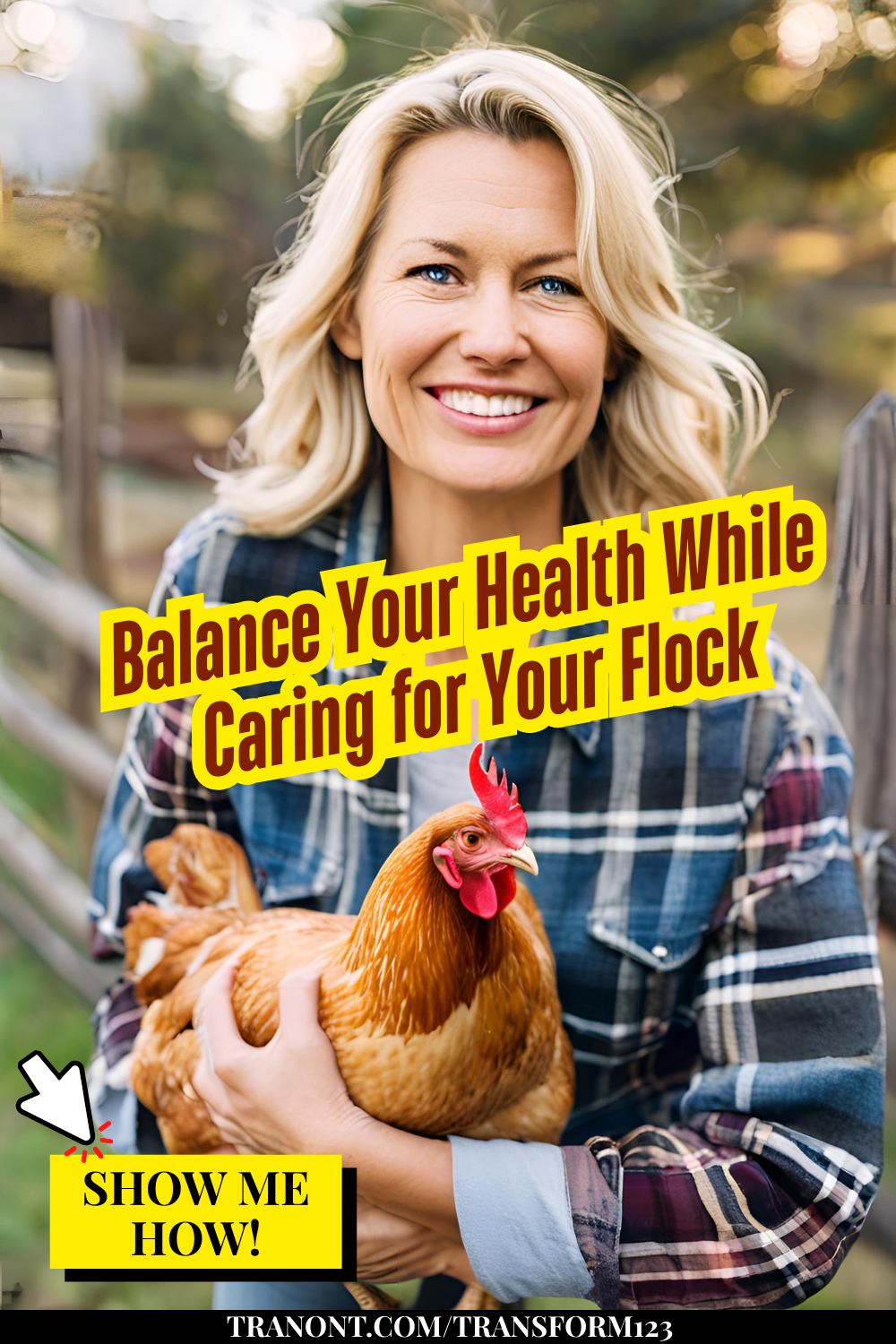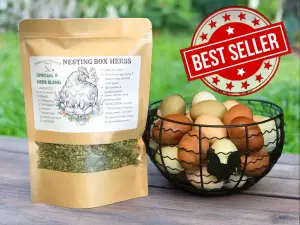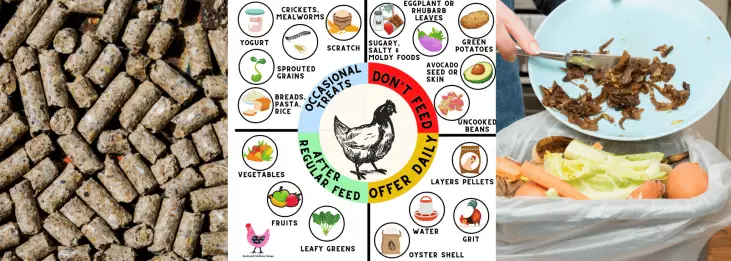
New chicken keepers often ask, “Is it safe to feed chickens table scraps?” Yes, as long as you offer your chickens their regular feed first and your table scraps do not include sugary, salty, moldy or poisonous foods. Table scraps should not consist of more than 10% of their daily food intake.
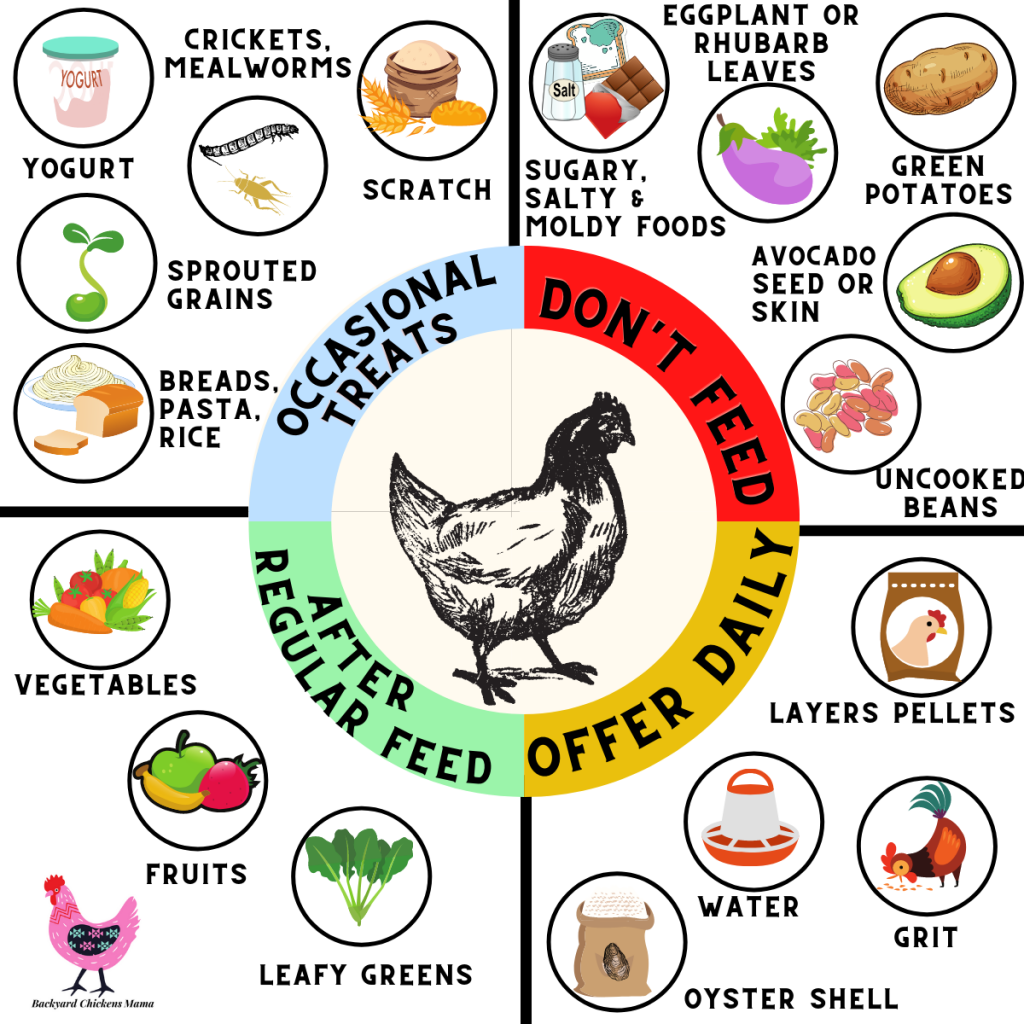
Most chicken owners love to give their chickens table scraps. It eliminates food waste and can cut down on feed cost for your flock. As long as you follow a few important tips, it should be perfectly fine to feed your chickens leftovers.
1. Offer Regular Chicken Feed First
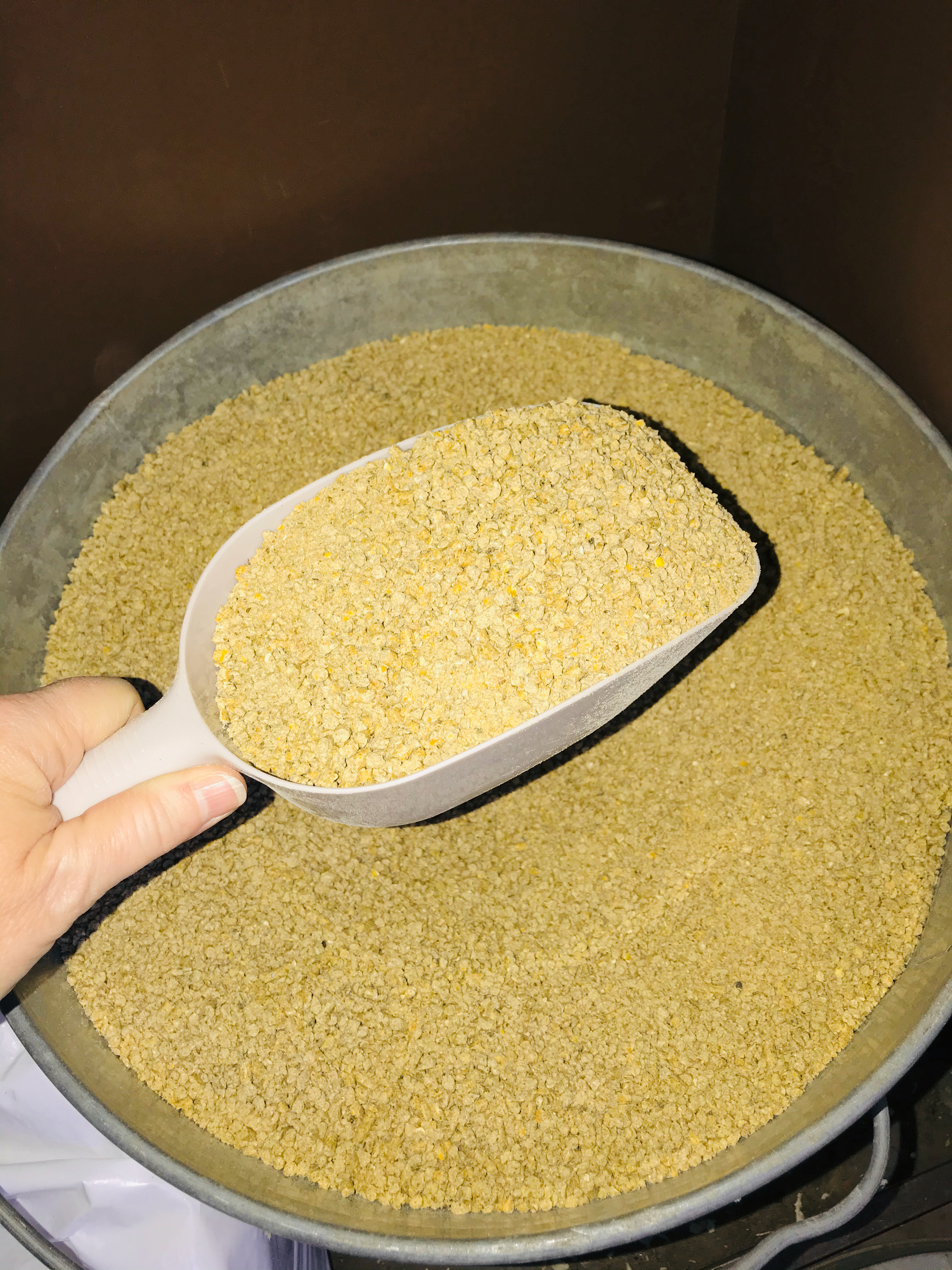
Offer regular chicken feed first because it contains the proper amount of daily nutrients. It’s important that chickens fill up with nutrients that they need the most. Most chickens will go for the table scraps first, so make sure they are finished with their main course before offering other foods.
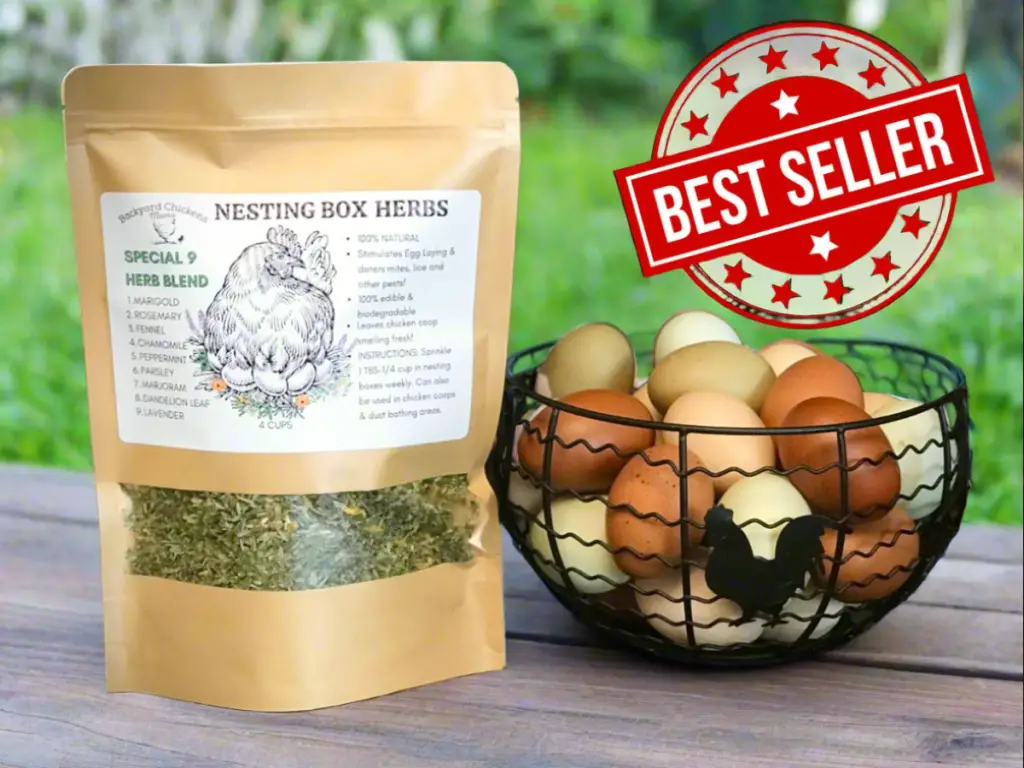
Increases egg laying naturally.
- Improves chicken health.
- Deters parasites: mites, lice, fleas & flies as well as mice, rats, raccoons, coyotes, opossums and more!
- On SALE!
- Shop: Nesting Box Herbs
Layers Feed & Chick Starter Feed
Always offer age appropriate feed for your growing chickens. Baby chicks need a higher protein feed than a laying hen. Laying hens need more calcium than a baby chick. This is why there are specific feeds for growing chicks and laying hens; layers pellets and chick starter.
Chick starter is available as crumbles or a mash. Layers feed is available as pellets, crumbles or a mash. Many chicken owners prefer the pellets, feeling that there is less of a mess with them.
| AGE | WHAT TO FEED | WHY |
|---|---|---|
| CHICKS 1-16 WEEKS | CHICK STARTER | ⬆️ PROTEIN ⬇️ CALCIUM |
| LAYING HENS 16 WEEKS ON | LAYERS FEED & OYSTER SHELL SUPPLEMENT | ⬇️ PROTEIN ⬆️ CALCIUM |
| MOLTING HENS | CHICK STARTER OR LAYERS FEED & PROTEIN TREATS | ⬆️ PROTEIN |
How Much Feed Does an Adult Chicken Eat?
The average amount of chicken feed that an adult chicken should have is 1/4 lb. of feed per day. This amount can vary, depending upon the breed and if your chickens are allowed to free range, where they have access to leafy greens, seeds and bugs.
Backyard Chickens Mama Article: 9 Important Signs to Look For – Are Your Chickens Happy?
Water
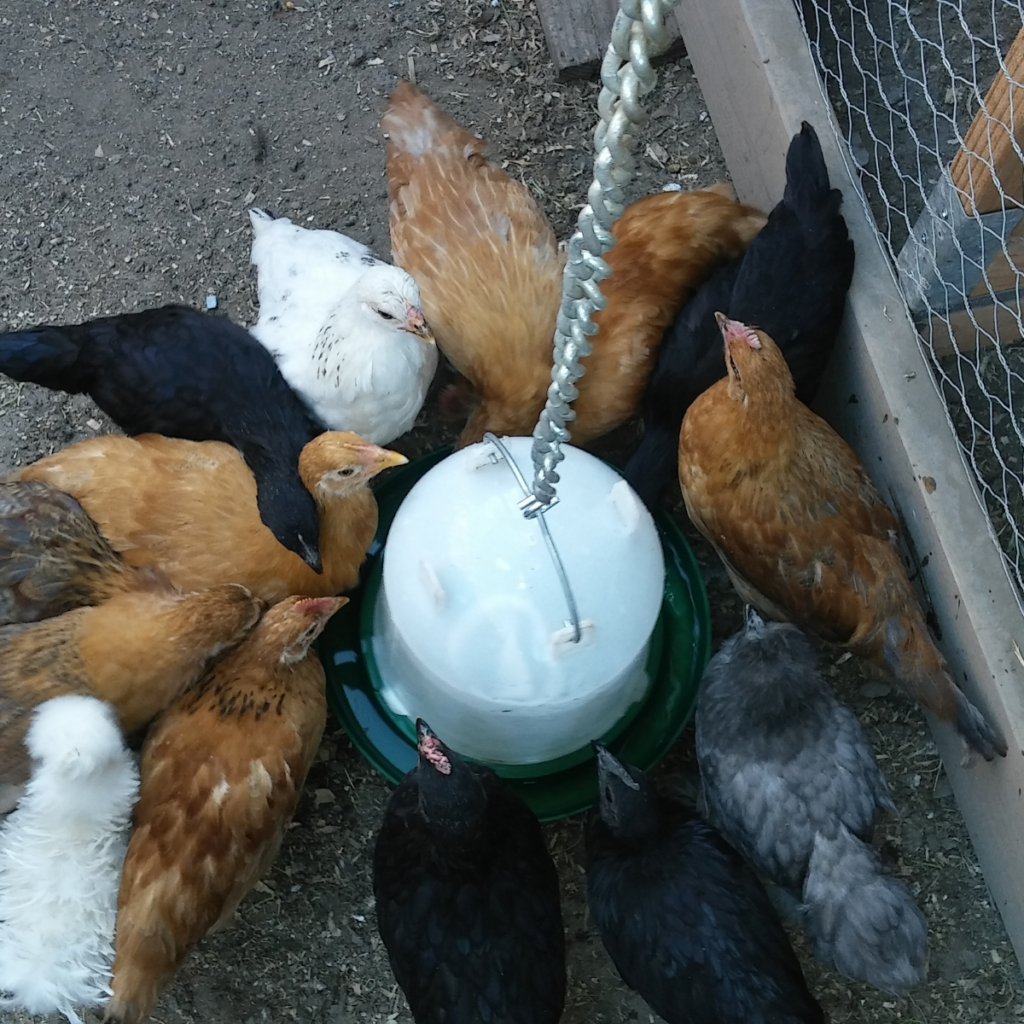
Chickens should always have access to water and during extreme heat, should have more than one source of water available. It would be awful if they only had one source of water that tipped over and they couldn’t cool down.
Chickens don’t sweat and instead use “evaporative cooling” to cool their bodies down. This is why it is so important to always have fresh, cool water available for them. During extreme heat, chickens can drink up to twice as much as usual.
How Much Water Does an Adult Chicken Drink?
The average amount of water that an adult chicken drinks is 1 pint per day. This amount can vary greatly depending upon the outdoor temperature and the breed of chicken. Chickens should always have access to an unlimited amount of clean water.
Backyard Chickens Mama Article: 9 Important Signs to Look For – Are Your Chickens Happy?
| WATER TIPS FOR KEEPING CHICKENS COOL |
|---|
| CHANGE WATER OUT DAILY |
| ADD ICE CUBES TO WATER |
| PLACE WATER IN SHADE |
| TOP WATER OFF FREQUENTLY WITH COOL WATER |
| HAVE MULTIPLE WATER SOURCES AVAILABLE |
For more really good tips on how to keep your chickens cool in extreme heat, read my article 17 Tips – How to Keep Chickens Cool in Extreme Heat.
How to Feed Oyster Shell to Chickens
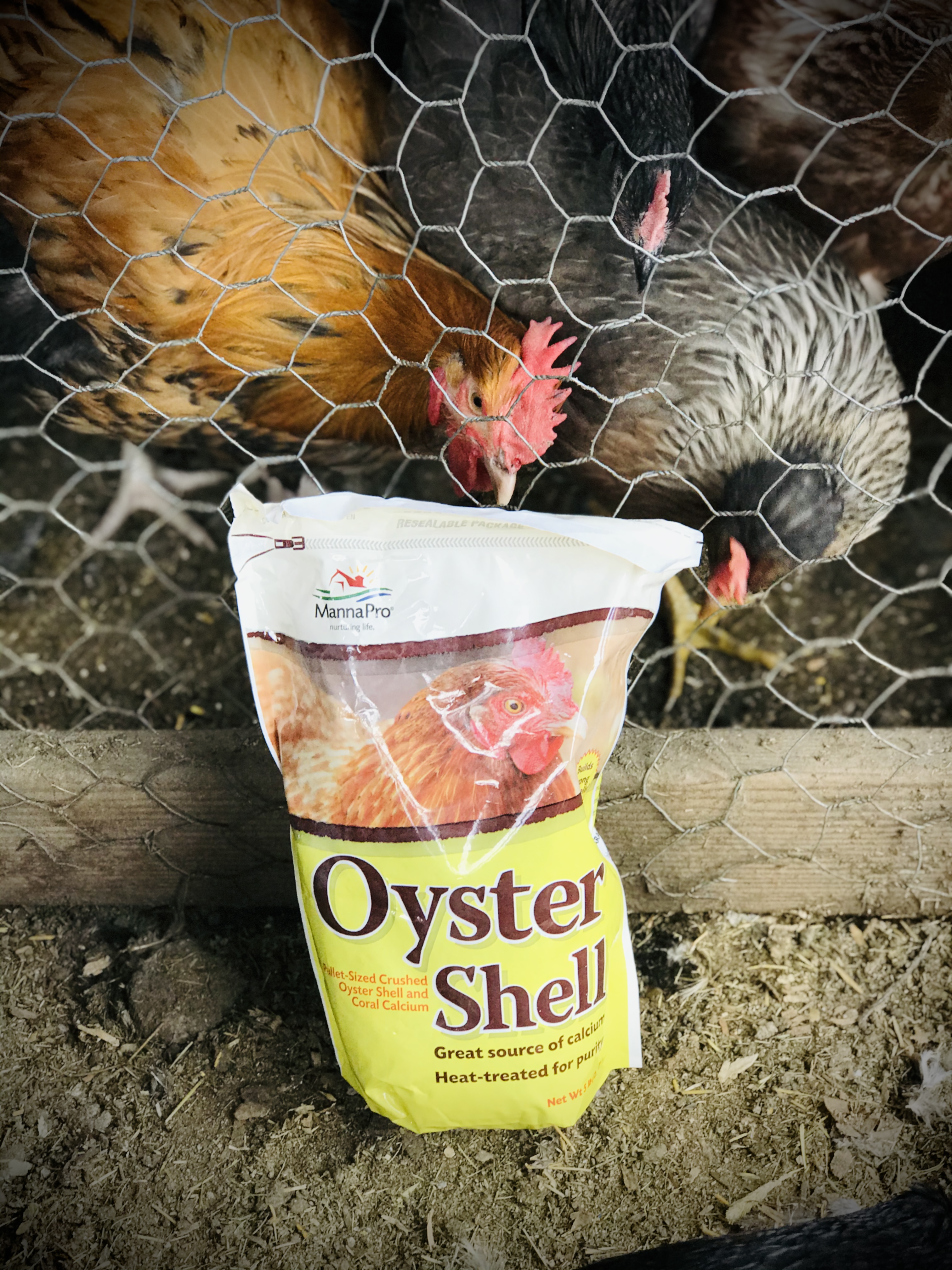
Oyster shell is important for laying hens because of the calcium content in it. Laying hens need extra calcium to produce an egg. If a laying hen is not provided with oyster shell, she will not lay as frequently, may even produce a soft shelled egg and can even suffer from brittle bones.
Mixing oyster shell with the feed does not allow your hens to self-regulate how much they consume and can cause them to consume too much calcium, which can lead to kidney problems. Instead, offer oyster shell separately for your hens.
A hen instinctively knows how much calcium her body requires and will self-regulate how much she consumes. I always have oyster shell available for my laying hens in a separate feeder that I hang on the side of my chicken run.
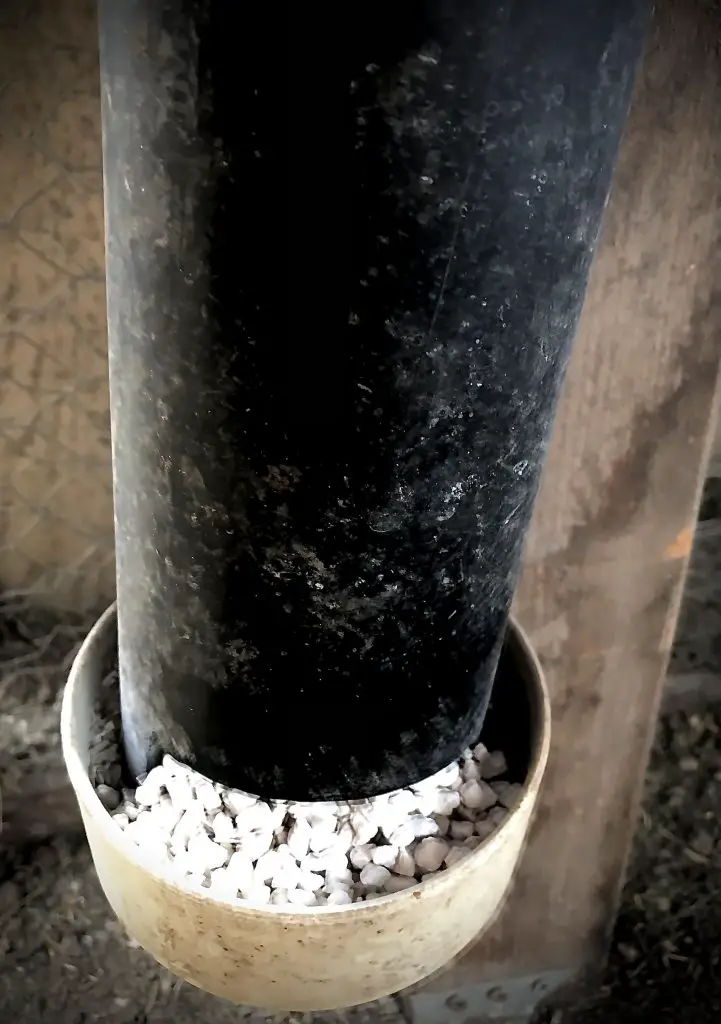
| AGE | CALCIUM REQUIREMENT |
|---|---|
| CHICKS 1-12 WEEKS | NO |
| YOUNG LAYING PULLETS (UP TO 1 YEAR) | 2.75 GRAMS |
| ADULT LAYING HENS | 4-5 GRAMS |
What is Grit and Why is Grit Important for Chickens?
Grit is fine pebbles or stones. Chickens that are confined and eat more than just layers feed need grit to help digest their food. Chickens do not have teeth and grit is what helps to grind up food in their gizzard before passing it through the intestines.
Chickens cannot chew food, so it sits in the crop and slowly is passed into the muscular part of the stomach, called the proventriculus. In here it is mixed with digestive juices and passed into the gizzard where grit helps to break down food even more.
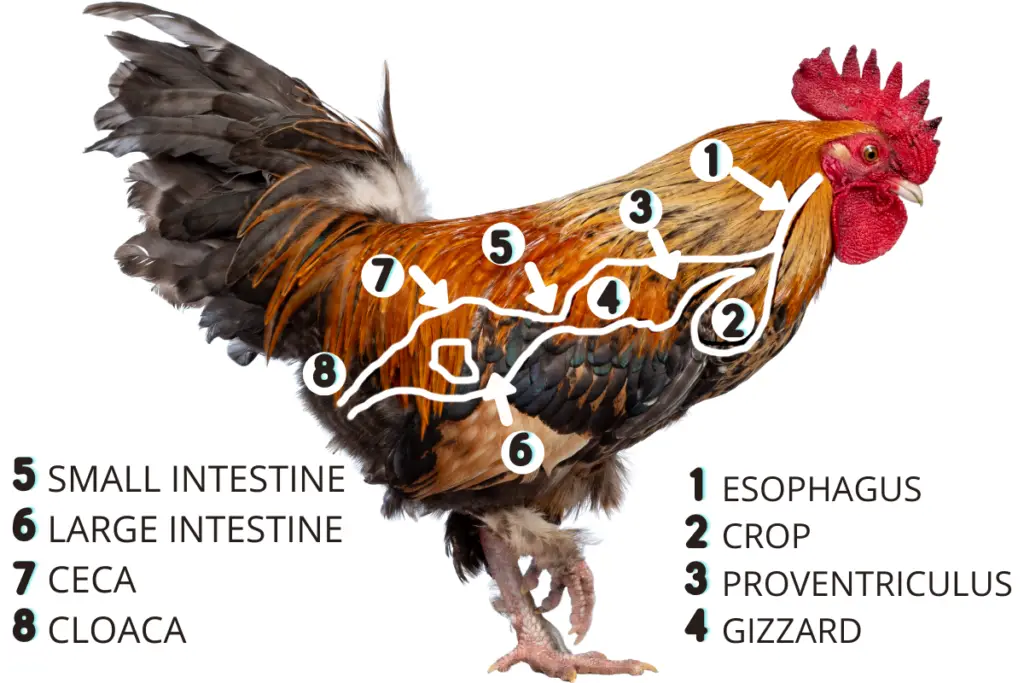
2. Table Scraps Shouldn’t Exceed 10% Daily Food Intake
While it’s fun to feed and watch your chickens go crazy over table scraps, it is important to not let it exceed 10% of its daily food intake. An adult size hen should eat about 1/4 lb. of feed a day. That’s about 1/2 cup of layers feed. So 10% is 0.8 TBS, or just shy of a tablespoon of treats per day.
3. Know What Foods Are Poisonous to Chickens
What Foods are Poisonous to Chickens?
It’s important to know what foods are poisonous to chickens. Some foods may be ok in moderation, but if given in larger quantities can cause toxicity, health problems or even death. Below is a list of foods that are toxic to chickens.
| FOOD TOXIC TO CHICKENS |
|---|
| AVOCADO SEED AND PEEL |
| RHUBARB |
| EGGPLANT LEAVES |
| APPLE SEEDS (LARGER QUANTITIES) |
| UNCOOKED BEANS |
| GREEN POTATOES |
| APRICOT LEAVES & PITS |
| MOLDY FOODS |
| CHOCOLATE |
| COFFEE GROUNDS |
| SPOILED FOOD |
4. What Scraps NOT to Feed Chickens: Don’t Offer Sugary, Salty or Moldy Foods to Chickens
Too much sugar, salt or consuming the wrong kind of mold can have serious health effects on your chickens and even cause a premature death. As chicken owners, we owe it to our flock to feed them a healthy diet.
Effects of Sugary Foods on Chickens
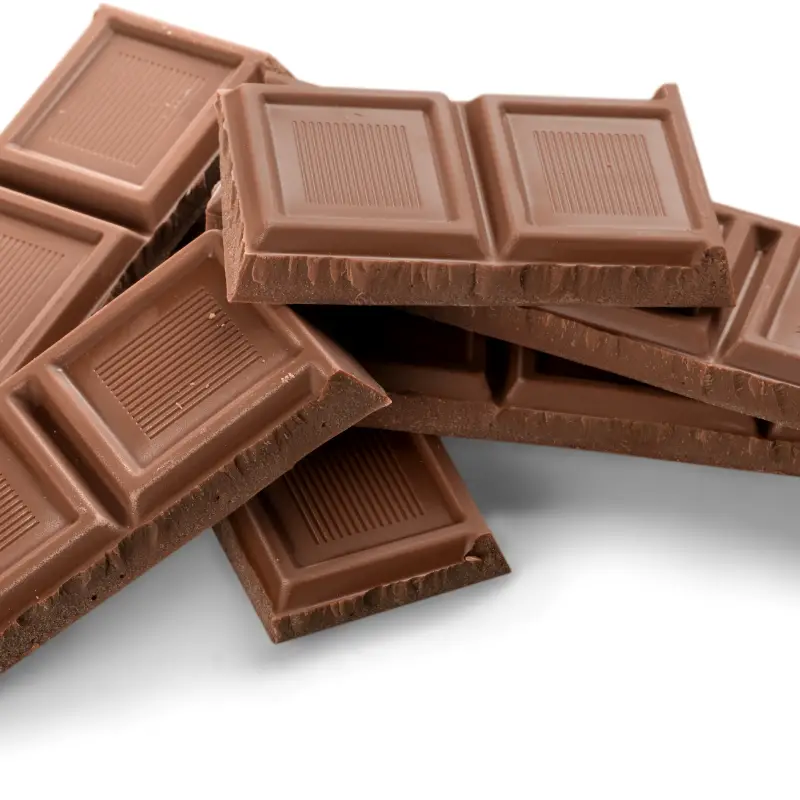
Chickens are no different than humans when it comes to sugar. Too much sugar can cause them to become overweight. Overweight chickens tend to have a decrease in egg production as well.
Too much sugary foods can lead to chicken sour crop. Avoid feeding too much starchy foods such as breads, pastas and rice. Carbohydrates turn into sugars. Too much sugary foods in a chickens “crop” can lead to chicken sour crop.
When feeding yogurt to chickens, choose plain yogurt, without the added sugary flavors. I have found the best yogurt to feed my chickens I can make in my Instant Pot.
Effects of Salty Foods on Chickens
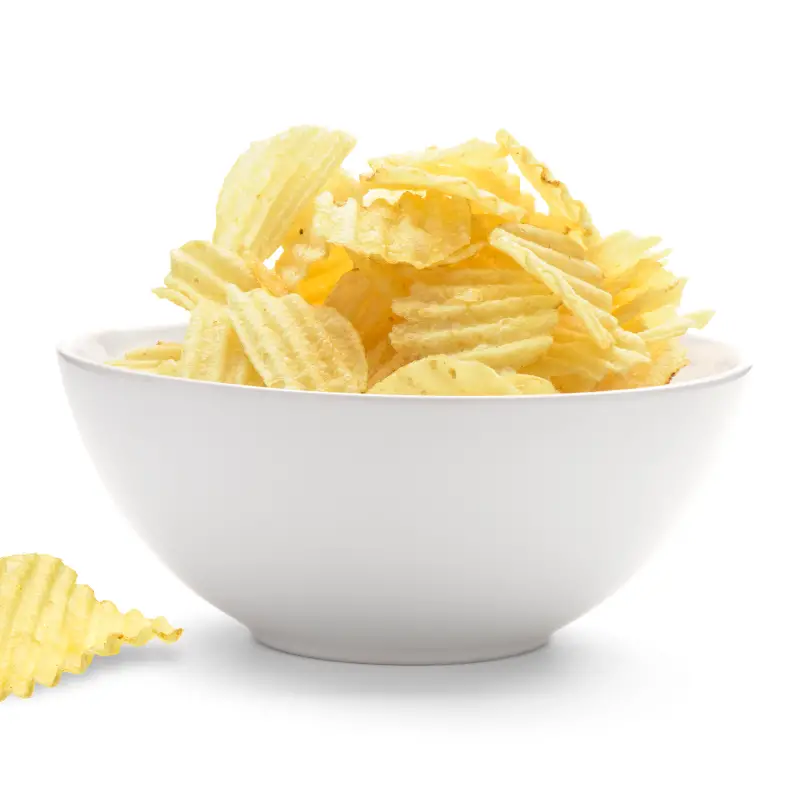
Chickens require a certain amount of salt in their diet (0.4-0.6% NaCl or 0.12-0.2% Sodium) and if you buy a good feed it should contain the recommended amount.
People that make their own feed or buy a lower quality feed may find that they need to supplement their chickens with additional salt. Salt can also be consumed in small amounts from eating earthworms and other tiny bugs.
Avoid feeding chickens salty foods such as lunch meats, ham and other table scraps with added salts. Too much salt can lead to toxicity and death. Younger chicks are more at risk of developing toxicity from too much salt in their diet.
| EFFECTS OF TOO MUCH SALT IN CHICKENS DIET |
|---|
| INCREASED THIRST |
| MALFORMED EGGS |
| DEPRESSION |
| INCOORDINATION |
| RESPIRATORY DISTRESS |
| DEATH |
Effects of Moldy Foods on Chickens
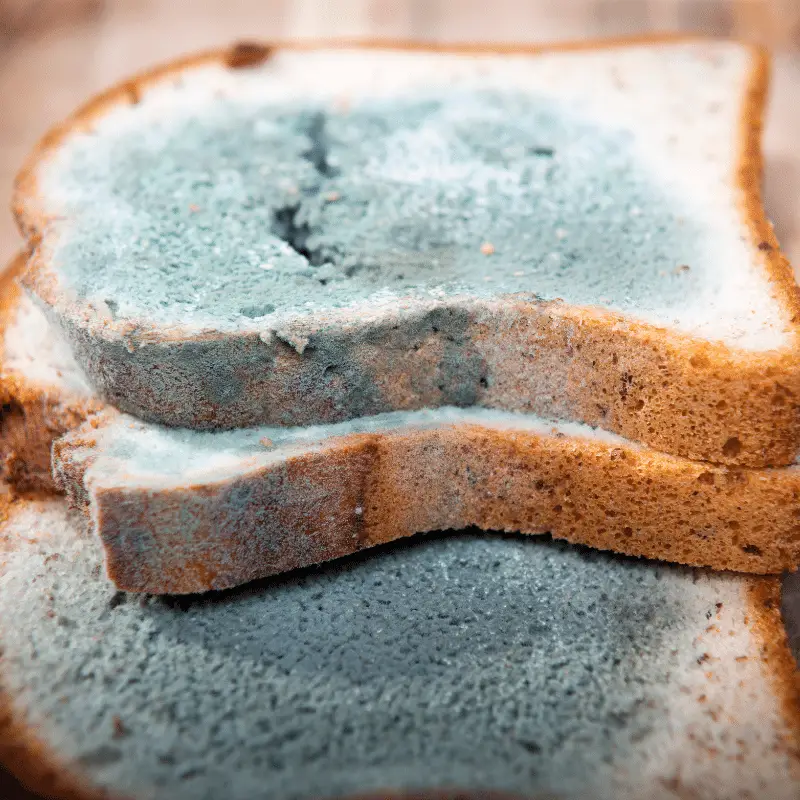
Just as you would not want to eat moldy foods because of health risks, you should avoid feeding it to your chickens as well. Moldy foods can make your chickens sick.
Chickens can develop mycotoxicoses by consuming mold that grows in their grain. It is the same thing as being exposed to a pesticide. Age and health of the chickens exposed can determine how susceptible they are to becoming poisoned.
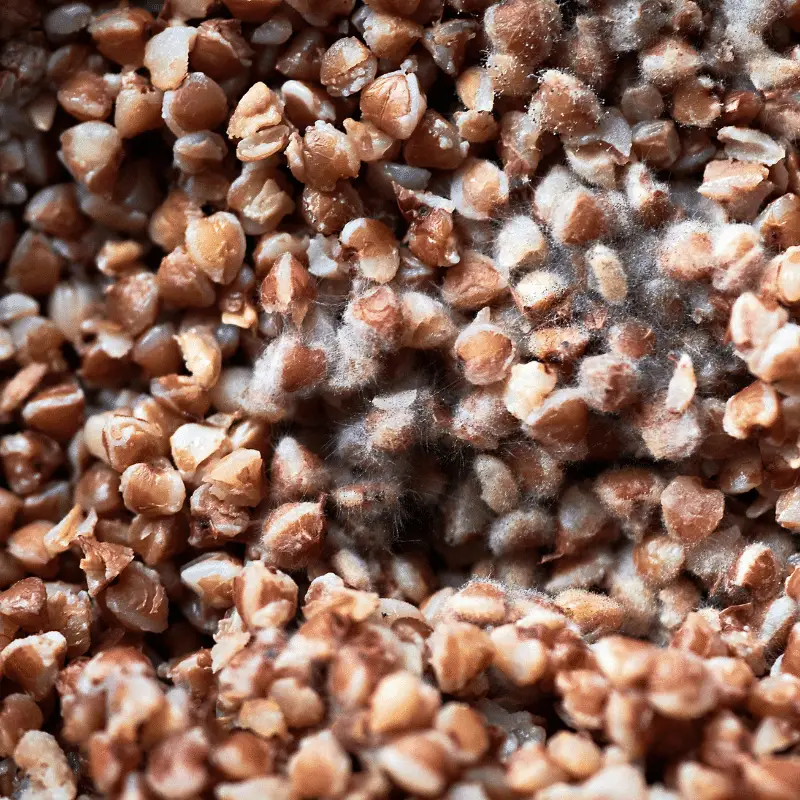
While most molds are beneficial or harmless, the one’s that aren’t can pack a powerful punch and kill a chicken. The deadly molds can attack a chicken’s skin and internal organs. Just to be safe, don’t feed any moldy foods to your chickens.
5. Consider Fermenting Chicken Feed
Soaking chicken feed in water causes a lacto-fermentation anaerobic process that enhances the feed and creates live Lactobacillus. Live Lactobacillus is a beneficial bacteria for your chickens gut that neutralizes the acid in the stomach, increasing the absorption of nutrients.
Fermenting your chicken feed “unlocks” nutrients within the feed that would not have been available to your flock. There is actually an increase in B vitamins such as niacin, folic acid, riboflavin and thiamin.
You will find that your chickens eat up to 20% less feed when you ferment it. This is because the nutrients are more readily available and with their nutritional needs being met, they will eat less. Less feed equals less money spent on feed!
Fermented feed will also benefit your chickens gut health, improve egg quality and increase egg laying. And the best thing is that if your chickens are eating less, they will poop less too!
| BENEFITS OF FEEDING FERMENTED CHICKEN FEED |
|---|
| UNLOCKS ADDITIONAL NUTRIENTS |
| INCREASES ABSORPTION |
| NEUTRALIZES STOMACH ACIDS |
| DECREASED FEED COST |
| IMPROVED GUT HEALTH |
| IMPROVED EGG QUALITY |
| DECREASED POOP |
| IMPROVED EGG TASTE |
| INCREASE EGG LAYING |
How to Ferment Chicken Feed
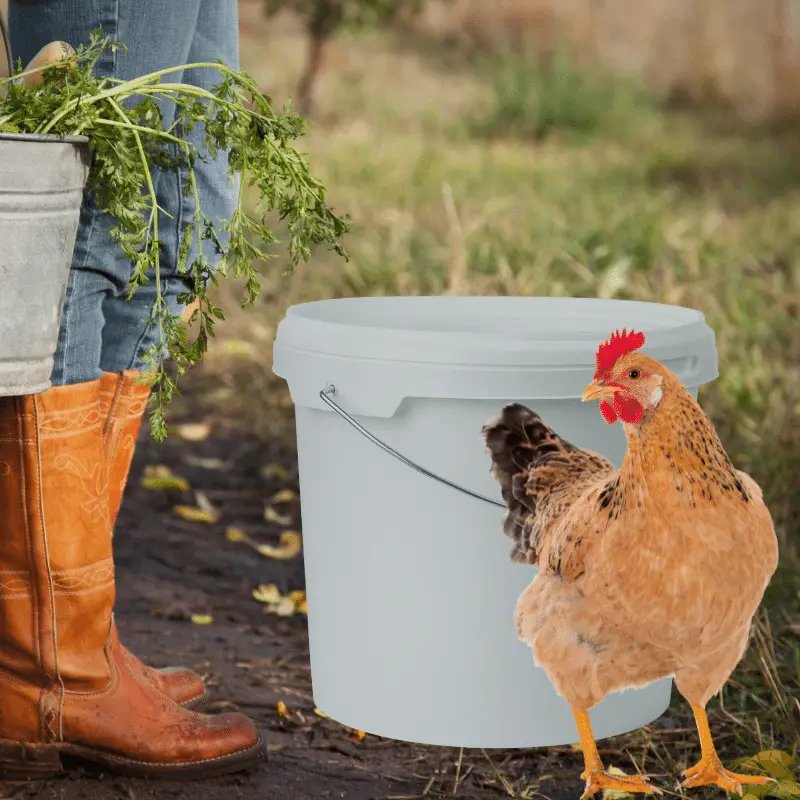
Choose your chicken feed. You can use layers pellets, crumbles or mash for laying hens and chick crumbles or mash for your young chicks and pullets. Soaking, frequent stirring and topping off with dechlorinated water will cause the feed to lacto-ferment, creating so many benefits.
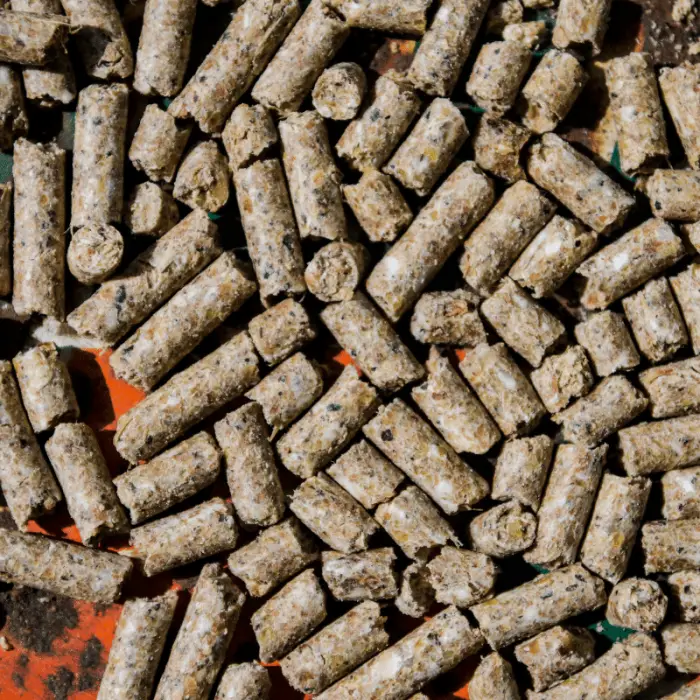
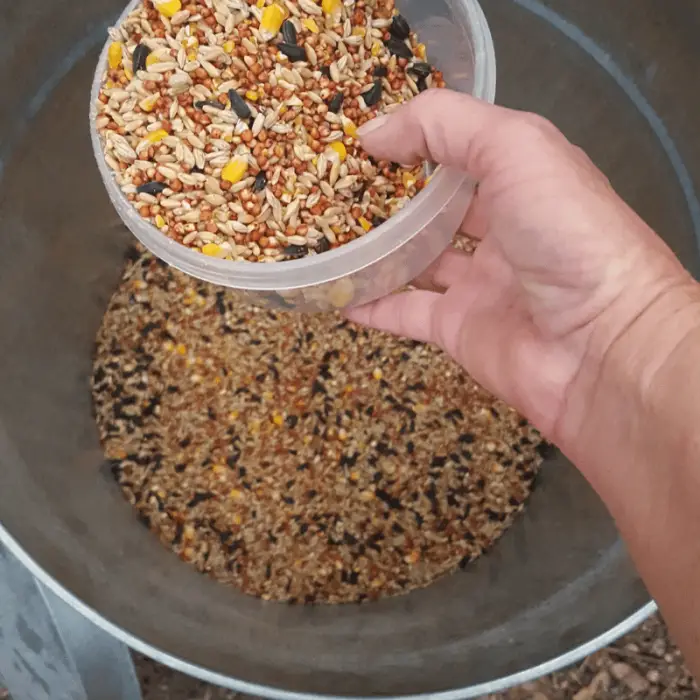
Day 1: I place about 2 days worth of feed or grains in a bucket and cover it with about 4″ of dechlorinated water. The feed expands as it absorbs water. I then place a lid on the bucket. (To make your own dechlorinated water, just set tap or hose water out for 24 hours.)
Day 2: I stir feed a few times during the day and top off with more dechlorinated water. Make sure water covers the feed or grain at all times. When you start to see little white foam or bubbles on the surface, this is the lacto-fermentation process occurring. It may also smell sweet, like yogurt.
Day 3: I stir the feed a few times throughout the day and top off with more dechlorinated water. At no time should the fermented feed smell sour, like alcohol or have mold on it. If it does, it was exposed to oxygen and needs to be discarded.
Day 4: I strain the water and feed the fermented feed to my chickens! I always leave some of the fermented feed and I reuse the water to speed up the process for my next batch. This way, I do not have to start over. I just take what I need to feed my flock each day and add new feed daily.
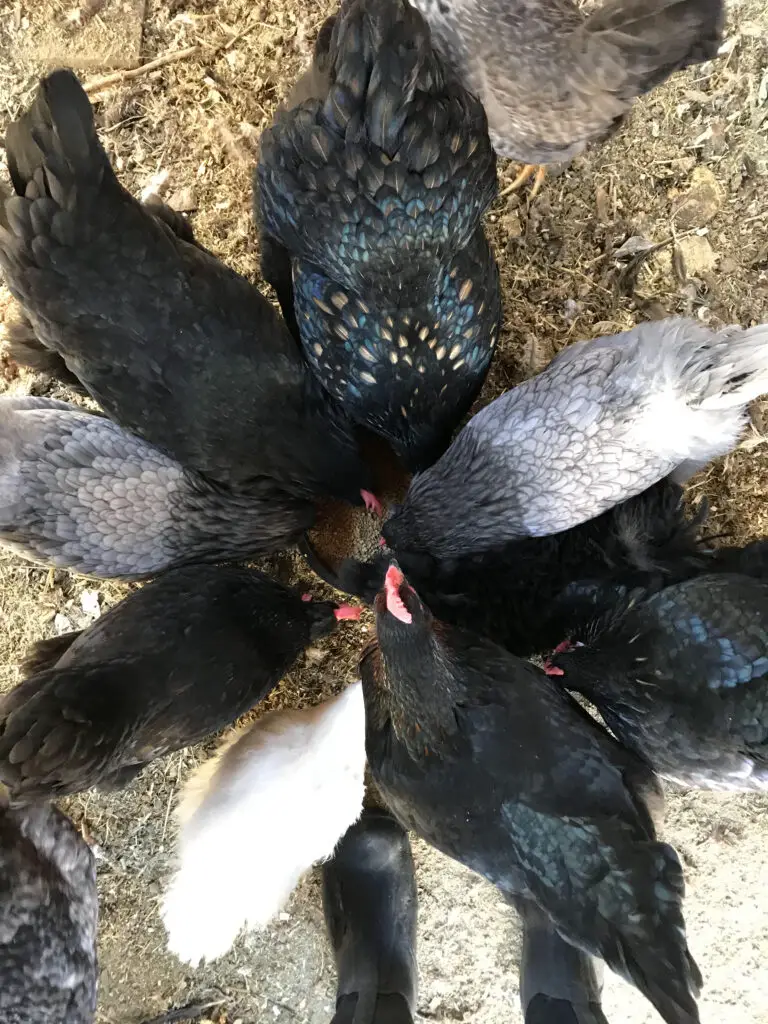
CONCLUSION: Is it Safe to Feed Chickens Table Scraps?
It is completely safe to feed your chickens table scraps as long as you follow these guidelines:
- Offer regular feed first.
- Table scraps should not exceed 10% of daily food intake.
- Know what foods are poisonous foods to chickens.
- Avoid sugary, salty or moldy foods.
- Consider fermenting your feed to increase the nutrient content.
Following these guidelines will result in happier, healthier and more productive chickens!
